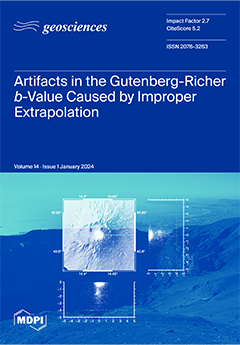Here, we characterize the statistical behaviour of the Mt. Vesuvius seismicity using distinct available catalogues. Our analysis confirms that for this area, the GR distribution exhibited two scaling regimes of the
b-value, not commonly observed for the standard frequency-magnitude distribution of earthquakes.
[...] Read more.
Here, we characterize the statistical behaviour of the Mt. Vesuvius seismicity using distinct available catalogues. Our analysis confirms that for this area, the GR distribution exhibited two scaling regimes of the
b-value, not commonly observed for the standard frequency-magnitude distribution of earthquakes. By assuming a physical cause, we tested four different hypotheses for the source of the break in the scaling: finite size effect, depth variations in the
b-value, radial dependence in the
b-value, and different
b-values for swarm and non-swarm events. None of the above reasons are able to explain the observation. Thus, we investigated the possibility of some pitfalls in magnitude estimation. Based on our analysis, we suggest there is a bias in the duration magnitude the catalogues are based on. This is due to the arbitrary extrapolation to smaller magnitudes of a linear regression derived for earthquakes with
. When a suitable correction is applied to the estimated magnitude, the GR distribution assumes the usual shape, with a
b-value closer to that usually observed in volcanic areas. Finally, the analysis of the time variation of some statistical parameters reveals that the state of the volcano appears to be stationary over the entire analysed period, possibly with only a slight increase in the
b-value, indicating a small reduction in differential stress.
Full article





